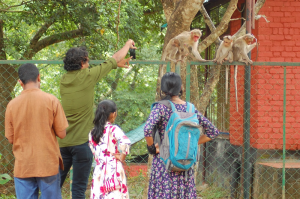Balasubramaniam K, Kaburu, S, Marty P, Beisner B, Bliss-Moreau E, Arlet ME, Ruppert N, Ismail A, Anuar Mohd Sah S, Mohan L, Rattan S, Kodandaramaiah U, McCowan B. 2021. Implementing social network analysis to understand the socio-ecology of wildlife co-occurrence and joint interactions with humans in anthropogenic environments. Journal of Animal Ecology DOI: 10.32942/osf.io/zf2ug The aim of our research was to compare three species of free-living macaques in terms of the dynamics of interactions with humans, and the dynamics of their behavior towards each other in groups. We conducted our observations among rhesus monkeys, long-tailed macaques, and bonnet macaques in southern Asia. Based on this data, we have created networks of macaque-human and macaque-macaque interaction. Our research showed that in all groups of macaques, the relationships of individuals within human networks were similar to their relationships in their groups. We also showed that males were mainly the ones who took risks by interacting with humans on multiple occasions. Our results suggest that for species that live close to humans, positive interactions between individuals and their greater tolerance towards each other may be the key to keep strong social bonds within the group.
Human population expansion into wildlife habitats has increased interest in the behaviour and ecology of interactions between people and animals. Still, however, is not clear, if and how wild animals do bond with each other, in the context of their interactions with humans. In our study we adopted a comparative approach to address this gap, using social network analysis (SNA). SNA, increasingly used to determine human impact on wildlife ecology, can be a powerful tool to understand how animal behavior and ecology influence their interactions with people. For 10 groups of the rhesus, long-tailed, and bonnet macaques (Macaca spp.) living in human-impacted habitat in Asia, we collected data on human-macaque interactions, animal demographics, and macaque-macaque interactions. Then, we constructed ‘human co-interaction networks’ based on associations between macaques that interacted with humans within the same time and place, and social networks based on macaque-macaque grooming, affiliative behaviors of short duration and proximity. We found that for all macaque groups, human co-interaction networks showed non-random structures: connectedness within networks were similar to their connectedness within macaque group social networks. Moreover, male macaques interacted with humans more than females. Our findings suggest that for species living close to people, less time-consuming positive interactions and additionally greater social tolerance may be key to animals maintaining strong social connections within their groups. From conservation and public health perspectives, human and wildlife interaction networks may inform interventions to mitigate zoonotic disease transmission and move human-wildlife interactions from conflict towards better co-existence.
